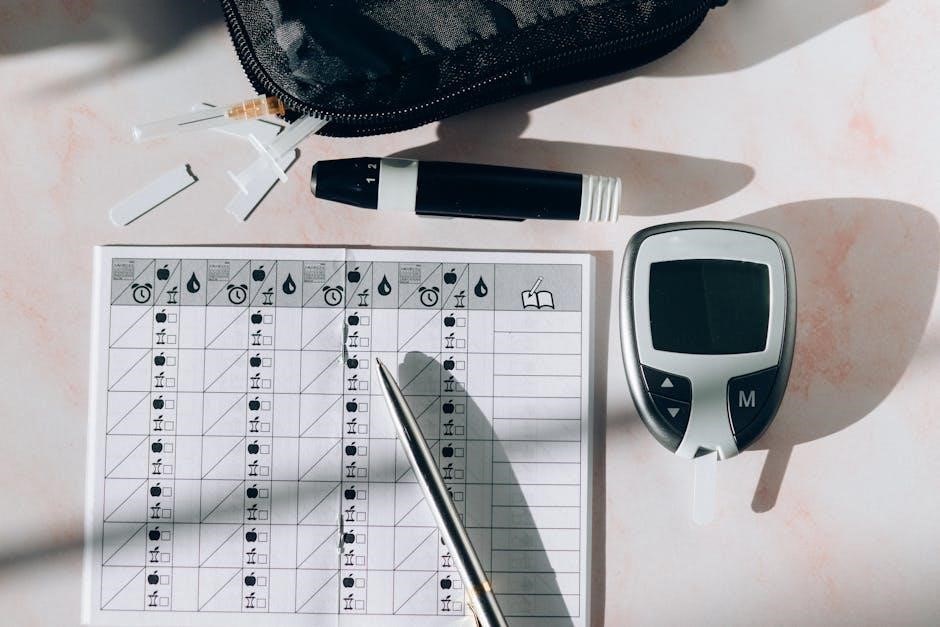A Vital Signs Record Sheet is a document used to track and monitor key health metrics like blood pressure, heart rate, and temperature. It provides a structured format for recording essential physiological measurements, enabling healthcare providers to assess patient health and detect potential issues early. Regular use of these sheets ensures accurate documentation, supports informed decision-making, and enhances overall patient care.
Definition and Purpose
A Vital Signs Record Sheet is a document designed to systematically track and document essential physiological measurements, such as blood pressure, heart rate, respiratory rate, body temperature, and oxygen saturation. Its primary purpose is to provide healthcare providers with a clear and organized way to monitor a patient’s health status over time. By recording these metrics, the sheet helps identify normal baselines, detect deviations, and assess responses to treatments. It serves as a critical tool for early detection of potential health issues, enabling timely interventions and improving patient outcomes. The sheet is widely used in clinical settings, home care, and personal health management to ensure accurate and consistent monitoring.
Importance in Healthcare
Vital Signs Record Sheets play a crucial role in healthcare by providing essential data for patient assessment and care. They enable healthcare providers to monitor physiological changes, detect early warning signs of complications, and evaluate treatment effectiveness. Accurate and timely documentation of vital signs is critical for identifying patterns, making informed decisions, and ensuring patient safety. These records also serve as legal documents, protecting both patients and providers by maintaining a clear history of care. By standardizing the collection of vital signs, these sheets promote consistency, reduce errors, and enhance the quality of healthcare delivery. Their importance extends to both clinical and home care settings, making them indispensable tools in modern medicine.
Key Components of a Vital Signs Record Sheet
A Vital Signs Record Sheet typically includes essential sections for documenting key health metrics. It features fields for blood pressure, heart rate, respiratory rate, body temperature, and oxygen saturation. Additional sections may include spaces for notes, timestamps, and patient identifiers to ensure clarity. The layout is designed for ease of use, allowing multiple entries over time to track trends. Customization options enable users to tailor the sheet to specific needs, such as adding fields for pain levels or glucose monitoring. The inclusion of baseline metrics helps in comparing future readings, while clear instructions guide accurate data entry. These components collectively ensure comprehensive and organized recording of vital signs, supporting effective patient monitoring and care.

Why Monitor Vital Signs?
Monitoring vital signs allows early detection of health issues, guides treatment decisions, and tracks progress over time, ensuring timely interventions and improved patient outcomes.
Early Detection of Health Issues
Regular monitoring of vital signs enables healthcare providers to identify abnormalities early, such as elevated temperature or irregular heart rate, which may signal underlying conditions like infections or cardiovascular problems. By detecting these deviations from baseline metrics, interventions can be implemented promptly, potentially preventing severe complications. For instance, a sudden drop in oxygen saturation can indicate respiratory distress, while rising blood pressure may suggest hypertension or kidney issues. Early detection not only improves patient outcomes but also reduces the risk of emergencies. This proactive approach ensures timely medical attention, making vital sign tracking a cornerstone of preventive care and effective patient management.
Monitoring Treatment Progress
Monitoring treatment progress through vital signs is crucial for assessing patient response to interventions. By tracking changes in blood pressure, heart rate, and oxygen saturation, healthcare providers can evaluate the effectiveness of medications or therapies. For example, a consistent drop in blood pressure may indicate successful hypertension management, while stable oxygen levels could signal improved respiratory function. This data also helps identify potential side effects or treatment failures early, allowing for timely adjustments. Regular updates in a vital signs record sheet enable clinicians to make informed decisions, ensuring personalized and effective care. This continuous assessment plays a key role in optimizing patient outcomes and achieving treatment goals.
Establishing Baseline Health Metrics
Establishing baseline health metrics is essential for understanding a patient’s normal physiological state. By recording vital signs such as heart rate, blood pressure, and respiratory rate during initial assessments, healthcare providers create a reference point for future comparisons. This baseline helps identify deviations from normal, which can indicate potential health issues. For instance, a patient’s usual blood pressure of 120/80 provides context for evaluating readings outside this range. Using a vital signs record sheet ensures consistency and accuracy in documenting these metrics. Over time, this data aids in tracking subtle changes, enabling early detection of trends and patterns that may signal underlying conditions or improvements in health.

Key Vital Signs to Record
Key vital signs include blood pressure, heart rate, respiratory rate, body temperature, and oxygen saturation. These metrics provide crucial insights into a patient’s physiological state and overall health.
Blood Pressure (BP)
Blood pressure (BP) is a critical vital sign measuring the force of blood against artery walls. It is recorded as systolic (top value) and diastolic (bottom value) in millimeters of mercury (mmHg). Normal BP typically ranges from 90/60 to 120/80 mmHg, though this can vary based on age, health, and physical condition. Elevated BP may indicate hypertension, while low BP could signal hypotension. Accurate BP measurement is essential for assessing cardiovascular health and detecting potential issues early. Regular documentation in a vital signs record sheet helps track trends, enabling healthcare providers to monitor treatment effectiveness and make informed decisions. Consistent monitoring is vital for maintaining patient well-being.
Heart Rate (HR)
Heart rate (HR) measures the number of heartbeats per minute (bpm) and is a key indicator of cardiovascular health. Normal HR ranges from 60 to 100 bpm for adults, varying by age, fitness level, and health status. Newborns typically have higher rates, up to 160 bpm. A resting HR within this range usually indicates good health, while abnormal rates may signal conditions like tachycardia (fast HR) or bradycardia (slow HR). Monitoring HR trends over time helps healthcare providers assess physical condition, detect irregularities, and evaluate the effectiveness of treatments. Recording HR in a vital signs record sheet ensures consistent tracking and supports accurate patient care decisions. Regular documentation is crucial for early detection of potential issues and maintaining optimal health outcomes.
Respiratory Rate (RR)
Respiratory rate (RR) measures the number of breaths per minute (bpm) and is a critical indicator of respiratory health. A normal RR for adults typically ranges from 12 to 20 bpm, though this can vary by age, fitness level, and overall health. Elevated rates may indicate respiratory distress, infection, or other conditions, while abnormally low rates could signal neurological issues or metabolic disorders. Monitoring RR helps healthcare providers assess oxygenation, detect early signs of respiratory compromise, and evaluate the effectiveness of treatments. Accurate documentation of RR in a vital signs record sheet is essential for identifying trends, guiding clinical decisions, and ensuring comprehensive patient care. Regular tracking supports timely interventions and improves health outcomes.
Body Temperature (T)
Body temperature (T) is a fundamental vital sign measured in degrees Celsius or Fahrenheit, reflecting the body’s thermal state. Normal temperature typically ranges from 36°C to 37.8°C, though variations can occur based on factors like age, activity, and measurement method. Elevated temperatures may indicate infection, inflammation, or illness, while low temperatures could signal hypothermia or metabolic issues. Monitoring T helps healthcare providers assess systemic health, detect infections early, and evaluate treatment responses. Documenting temperature in a vital signs record sheet allows for trend analysis, guiding clinical decisions to prevent complications and improve patient outcomes. Accurate recording ensures timely interventions and supports comprehensive care.
Oxygen Saturation (SpO2)
Oxygen saturation (SpO2) measures the percentage of oxygen-carrying hemoglobin in the blood, providing insight into respiratory and cardiovascular health. Normal SpO2 levels typically range from 95% to 100%. Lower levels may indicate respiratory distress, such as chronic obstructive pulmonary disease (COPD) or pneumonia, while significantly reduced SpO2 can signal critical conditions requiring immediate intervention. Monitoring SpO2 is crucial for assessing oxygen therapy effectiveness and identifying early signs of hypoxemia. Documenting SpO2 in a vital signs record sheet helps healthcare providers track trends, optimize treatment plans, and ensure adequate oxygenation, ultimately enhancing patient safety and improving clinical outcomes through data-driven care.

Design and Structure of a Vital Signs Sheet
A Vital Signs Sheet is designed with a clear layout, organized to ensure easy readability and efficient data entry. It typically includes sections for date, time, and patient ID, followed by columns for each vital sign (BP, HR, RR, T, SpO2). The structure allows for multiple entries over time, enabling trend tracking. Customization options, such as adding or removing fields, make it adaptable to specific needs. The design prioritizes simplicity and functionality, ensuring accurate and consistent documentation of patient health metrics.
Layout and Organization
The layout of a Vital Signs Record Sheet is meticulously designed for clarity and efficiency. It typically features a header section for patient identification, date, and time to ensure traceability. Below, a grid layout organizes columns for each vital sign (BP, HR, RR, T, SpO2) and rows for multiple time entries. This structure allows healthcare providers to quickly scan and compare measurements over time. The design minimizes clutter, promoting readability and reducing errors during documentation. Clear labels and spacing facilitate accurate data entry, ensuring that each measurement is easily identifiable. This organized format supports efficient monitoring and timely interventions, making it an indispensable tool in both clinical and home care settings. The sheet’s layout is customizable, catering to specific needs while maintaining its user-friendly and functional design. By prioritizing organization, it enhances the accuracy and effectiveness of vital sign tracking, ultimately contributing to better patient outcomes. Additionally, the inclusion of spaces for notes or comments provides a place for any additional observations, further enriching the patient’s health record. Overall, the layout and organization of the Vital Signs Record Sheet are tailored to streamline workflows and improve patient care quality.
Spaces for Multiple Entries
Vital Signs Record Sheets are designed with spaces for multiple entries, allowing healthcare providers to track changes in a patient’s condition over time. This feature is essential for monitoring trends, such as gradual improvements or declines in health metrics. Each entry typically includes columns for date, time, and individual vital signs like blood pressure, heart rate, and oxygen saturation. This structured format ensures consistent and organized documentation, making it easier to identify patterns or anomalies. The ability to record multiple measurements also supports early detection of potential health issues, enabling timely interventions. These sheets are available in formats like PDF, PNG, and JPG, offering flexibility for different needs and preferences. Customization options further enhance usability, allowing users to tailor the layout to specific requirements. By providing ample space for repeated entries, Vital Signs Record Sheets facilitate comprehensive and continuous patient monitoring, which is critical in both clinical and home care settings. This design ensures that all relevant data is captured efficiently, promoting accurate assessments and informed decision-making. The inclusion of multiple entry spaces also makes these sheets versatile, accommodating varying durations of patient care and different frequencies of measurement. Overall, this feature underscores the practicality and effectiveness of Vital Signs Record Sheets in maintaining thorough and reliable health records.
Customization Options
Vital Signs Record Sheets offer customization options to meet specific needs. Users can add or remove fields, such as including additional health metrics like pain levels or nutritional intake. Fonts and colors can be adjusted for better readability or to align with institutional branding. Some templates allow for the incorporation of logos or hospital names, enhancing professionalism. Customization ensures the sheets are tailored to individual patient requirements or organizational standards. These options make the documents versatile for various healthcare settings, from clinics to home care. By adapting the layout and content, users can prioritize relevant information, improving efficiency and patient outcomes. This flexibility ensures the sheets remain practical and user-friendly for diverse applications.

Where to Find Vital Signs Record Sheets
Vital Signs Record Sheets are available online as free printable templates, ideal for personal or clinical use. They can be downloaded from medical websites, EHR systems, or through healthcare institutions, ensuring easy access for caregivers and professionals to monitor patient health effectively.
Free Printable Templates Online
Free printable vital signs templates are widely available online in PDF, PNG, and JPG formats. These templates are designed for easy tracking of temperature, pulse, respiration, and blood pressure. They come in A4 and US Letter sizes, making them versatile for various needs. Many websites offer customizable options, allowing users to modify fonts, colors, or add/remove fields as required. Ideal for clinics, caregivers, and personal use, these templates provide a structured way to monitor health metrics. They can be downloaded from medical websites, EHR systems, or platforms like CareClinic, ensuring accessibility for both professionals and individuals. This convenience makes maintaining health records straightforward and efficient.
Medical Institutions and Clinics
Medical institutions and clinics commonly use vital signs record sheets to monitor patients’ health effectively. These sheets are often tailored to meet the specific needs of healthcare facilities, ensuring consistent and accurate data collection. They are utilized in both in-patient and out-patient settings, providing a standardized method for tracking vital signs. Many clinics incorporate additional fields for notes or specific metrics, such as oxygen saturation, to enhance patient care. By maintaining these records, healthcare providers can quickly identify trends, detect potential issues early, and guide treatment plans. This structured approach ensures efficient monitoring and supports better decision-making in clinical environments.
Electronic Health Record (EHR) Systems
Electronic Health Record (EHR) systems are a modern and efficient way to manage vital signs documentation. These digital platforms integrate vital signs data seamlessly, allowing healthcare providers to access and update patient records in real-time. EHR systems enhance accuracy, reduce errors, and improve care coordination. They also offer secure storage and easy sharing of records among authorized personnel. Many EHR systems include built-in templates for vital signs, enabling quick and standardized data entry. Additionally, EHRs support trend analysis, helping practitioners identify changes in patient conditions over time. With robust security measures, such as encryption and HIPAA compliance, EHR systems ensure patient data remains confidential while providing a reliable tool for healthcare professionals.

How to Use a Vital Signs Record Sheet
A Vital Signs Record Sheet is used to systematically document health metrics like blood pressure, heart rate, and temperature. It provides a structured format for accurate recording, ensuring consistency and informed decision-making in patient care.
Step-by-Step Guide
Using a Vital Signs Record Sheet involves several straightforward steps. Start by preparing the sheet, ensuring all necessary fields are included, such as blood pressure, heart rate, respiratory rate, temperature, and oxygen saturation. Next, accurately measure and record each vital sign using appropriate medical devices. Enter the data in the corresponding sections, noting the date and time of each measurement. Regularly review the recorded information to identify trends or abnormalities. Finally, store the completed sheet securely, ensuring compliance with privacy regulations like HIPAA. This systematic approach ensures accurate and reliable documentation of patient health metrics.
Best Practices for Accurate Recording
Accurate recording of vital signs is crucial for reliable patient care. Ensure all measurements are taken using calibrated medical devices and recorded promptly. Use clear, legible handwriting or digital entry to avoid errors. Document the date, time, and corresponding vital signs for each entry. Regularly review and verify the data for consistency and accuracy. Train staff on proper techniques for measuring vital signs to minimize variability. Implement double-checking procedures, especially for critical values. Use standardized units of measurement and avoid abbreviations that could lead to confusion. Finally, store the records securely, adhering to privacy regulations, to maintain patient confidentiality and data integrity.
Interpreting Trends and Patterns
Interpreting trends and patterns in vital signs is essential for identifying changes in a patient’s condition. By analyzing data over time, healthcare providers can detect subtle shifts, such as gradual increases in blood pressure or heart rate, which may indicate underlying issues. Consistent elevations in temperature could signal an infection, while downward trends in oxygen saturation may suggest respiratory distress. Early detection of these patterns allows for timely interventions, improving patient outcomes. Regular review of recorded vital signs helps in identifying normal baselines and deviations, enabling healthcare teams to make informed decisions and adjust treatment plans accordingly.

Customizing Your Vital Signs Sheet
Customizing your Vital Signs Sheet allows you to tailor it to specific needs, such as adding or removing fields, changing fonts, or incorporating additional health metrics for personalized tracking.
Adding or Removing Fields
Customizing your Vital Signs Sheet allows you to add or remove fields based on specific needs. For instance, you can include additional metrics like oxygen saturation or pain levels, or remove less relevant fields for simplicity. This flexibility ensures the sheet remains tailored to the patient’s condition or the healthcare setting, such as hospitals, clinics, or home care. By modifying fields, you can focus on the most critical data, improving efficiency and accuracy in patient monitoring. This customization also supports better tracking of patient progress and informed decision-making by healthcare providers. Adjusting fields ensures the sheet remains relevant and effective for diverse medical scenarios.
Changing Fonts and Colors
Customizing fonts and colors on a Vital Signs Sheet can enhance readability and user experience. Choose fonts that are clear and easy to read, such as Arial or Times New Roman, to ensure legibility. Colors can be adjusted to highlight important sections or differentiate between entries, making the document visually organized. For instance, using bold colors for headers or subtle shades for data rows can improve navigation. This customization also allows for personal or institutional branding, aligning the sheet with specific preferences or guidelines. By modifying fonts and colors, you can create a visually appealing and functional design that supports efficient data recording and interpretation.
Incorporating Additional Health Metrics
Incorporating additional health metrics into a Vital Signs Sheet can provide a more comprehensive view of a patient’s health. Metrics such as pain levels, glucose readings, or nutritional intake can be added to tailor the sheet to specific patient needs. This customization allows healthcare providers to monitor multiple aspects of a patient’s condition in one place, improving continuity of care. For example, including a section for oxygen therapy details or medication schedules can enhance tracking and management. By integrating these extra metrics, the sheet becomes a holistic tool that supports personalized treatment plans and fosters better patient outcomes through detailed and organized health monitoring.

Legal and Privacy Considerations
Ensuring compliance with HIPAA and protecting patient health information (PHI) is crucial when using Vital Signs Record Sheets. Proper measures like encryption and secure access must be implemented to maintain confidentiality and prevent unauthorized disclosure of sensitive data.
Protecting Patient Health Information (PHI)
Protecting Patient Health Information (PHI) is critical when using Vital Signs Record Sheets. Under HIPAA regulations, healthcare providers must ensure PHI is handled securely to prevent unauthorized access or disclosure. This includes using encrypted digital storage, secure access controls, and strict confidentiality agreements. Printed sheets should be stored in locked areas, and only authorized personnel should handle them. Audit trails and monitoring systems can help detect breaches. Proper training for staff on privacy practices is essential to maintain patient trust and comply with legal standards. Ensuring PHI protection is a shared responsibility between healthcare providers and organizations to safeguard sensitive patient data effectively.
Compliance with HIPAA Regulations
Compliance with HIPAA regulations is essential when handling Vital Signs Record Sheets. HIPAA mandates that all protected health information (PHI) must be securely stored, transmitted, and accessed. This includes using encrypted digital platforms for electronic records and ensuring physical sheets are kept in secure locations. Access to PHI must be restricted to authorized personnel only, with audit trails to monitor usage. Training staff on HIPAA guidelines is crucial to prevent data breaches. By adhering to these regulations, healthcare providers can maintain patient confidentiality and avoid legal penalties. Regular audits and updates to security protocols help ensure ongoing compliance and safeguard patient data effectively.
Ensuring Confidentiality
Ensuring confidentiality is a critical aspect of managing Vital Signs Record Sheets. Both digital and physical records must be protected from unauthorized access. Digital platforms should use strong passwords, encryption, and secure authentication methods. Physical sheets should be stored in locked cabinets with limited access. Staff must be trained on confidentiality protocols to prevent accidental disclosure. Patient identifiers should be minimized, and access logs maintained. Regular security audits help identify vulnerabilities. By implementing these measures, healthcare providers can safeguard sensitive patient information and maintain trust. Confidentiality is essential for ethical patient care and legal compliance, ensuring that vital signs data remains private and secure at all times.

Benefits of Using a Vital Signs Record Sheet
A Vital Signs Record Sheet enhances patient care by providing clear, organized health data. It improves tracking, supports informed decisions, and helps identify trends for better outcomes.
Improved Patient Care
Vital Signs Record Sheets play a crucial role in enhancing patient care by enabling healthcare providers to monitor health metrics accurately. These records allow for early detection of abnormalities, such as spikes in blood pressure or irregular heart rates, which can indicate underlying issues. By tracking trends over time, providers can identify patterns and intervene promptly, preventing potential complications. This tool also supports personalized treatment plans, ensuring therapies are tailored to individual needs. Consistent monitoring fosters better communication between healthcare teams and patients, improving overall outcomes. Ultimately, using a Vital Signs Record Sheet ensures proactive care, leading to safer and more effective patient management.
Enhanced Documentation
Using a Vital Signs Record Sheet significantly enhances documentation accuracy and organization. By providing a structured format, it ensures that all essential health metrics are clearly recorded and easily accessible. This tool reduces errors and improves the clarity of patient records, making it simpler for healthcare teams to review and communicate effectively. Enhanced documentation also promotes compliance with medical standards and regulations, ensuring that all data is captured consistently. With a centralized location for vital signs, healthcare providers can quickly identify trends and make informed decisions. This level of organization not only streamlines workflows but also contributes to better patient outcomes by ensuring that critical health information is readily available when needed.
Efficient Monitoring and Tracking
A Vital Signs Record Sheet facilitates efficient monitoring and tracking of a patient’s health status over time. By organizing data in a clear and structured manner, it allows healthcare providers to quickly identify trends and changes in vital signs. This tool is particularly useful for detecting subtle shifts in a patient’s condition, enabling early interventions. Regular tracking also supports the evaluation of treatment effectiveness, as changes in metrics like blood pressure or heart rate can indicate progress or potential issues. The ability to monitor multiple patients simultaneously further enhances efficiency, making it an invaluable resource for clinics and caregivers. This streamlined approach ensures that healthcare teams can respond promptly to any changes, improving overall patient care and outcomes.

Troubleshooting Common Issues
Common issues with vital signs records include inaccuracies, missing data, or discrepancies. Addressing these promptly ensures reliable tracking and accurate patient care.
Accuracy of Measurements
Accuracy in vital sign measurements is crucial for reliable patient care. Inaccurate readings can lead to misdiagnosis or inappropriate treatment. Common causes include improper measurement techniques, faulty equipment, or human error. Ensuring staff are well-trained in using devices and following standardized protocols minimizes errors. Regular calibration of equipment, such as blood pressure monitors, is essential. Double-checking readings and documenting them promptly helps maintain accuracy. Using high-quality, validated devices also reduces discrepancies. Adhering to best practices ensures reliable data collection, supporting effective patient monitoring and care.
Additionally, cross-verifying measurements with electronic health records (EHRs) can help identify inconsistencies. Timely addressing discrepancies ensures accurate tracking and informed decision-making.
Addressing Missing Data
Missing data in vital signs records can hinder accurate patient assessment and care. Identify gaps promptly and investigate causes, such as oversight or equipment malfunctions. Implement corrective actions, like retracing steps or estimating missing values based on trends. Develop protocols for incomplete entries, ensuring clarity on when and how to address gaps. Train staff to prioritize thorough documentation and conduct regular audits to minimize missing data. Use technology, such as automated reminders, to alert healthcare providers of incomplete records. Addressing missing data ensures continuity of care and maintains the integrity of patient records, supporting informed decision-making and effective monitoring.
Resolving Discrepancies in Records
Discrepancies in vital signs records must be addressed promptly to ensure accurate patient care. Begin by reviewing the record to identify the source of the inconsistency, such as transcription errors or equipment malfunctions; Correct the entry clearly, noting the reason for the change, and ensure the correction is initialed and dated. Documenting the resolution transparently maintains record integrity. Train staff to recognize and report discrepancies, fostering a culture of accountability. Regular audits can help detect inconsistencies early, preventing potential misunderstandings. Open communication among healthcare teams is essential to resolve issues collaboratively and maintain reliable documentation. Resolving discrepancies ensures accurate data for informed patient care decisions.
